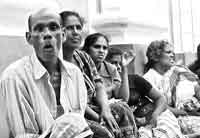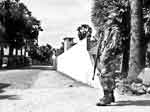Allaipiddy atrocity Sixty two-year-old Paulavina Norbert and her bed-ridden husband are some of the few people who have decided to stay back in this village, once home to more than 1,200 people. She is unable to forget the deadly sound of gunshots and the frightened screams of the victims that were heard from their neighbourhood and two other areas closeby on the night of May 13, when thirteen men, women and children were gunned down by a group of unidentified men.
Many of their neighbours have moved out of the village, either to Jaffna or to the LTTE controlled Wanni for safety. “We cannot leave this house. How can I can take my husband who is ill and live in a refugee camp or a welfare centre,” a worried Ms. Norbert asks. Less than 25 people now live in this village, which is part of the Kayts Island, situated close to the Jaffna mainland and linked by a causeway. The caretaker of St. Philip Neri’s Church, K. Pillendran, 72, is another villager who has decided to stay behind as he feels there is no one to take care of the church. On the night of May 13, it was this church which provided shelter to the traumatized men, women and children who escaped the carnage of that night. The Parish Priest Rev. Fr. A. Aamalaraj was the first to leave the safety of his church almost immediately after the shooting, to see to the people who had come under attack only to find most of them already dead. He found three people with gunshot injuries lying in a critical state and rushed them to the Jaffna General Hospital. He drove them himself in his own car, but unfortunately one of them succumbed to his injuries on the way to hospital. Frantic telephone calls soon followed. One of them was to the Jaffna District Judge Srinidhi Nandasekaram who in turn alerted the Kayts Magistrate Jeyaram Trotsky.
Acting promptly, Mr. Trotsky urged the Kayts police to provide him with security to visit the scene of the massacre. But the request was turned down on the grounds that they did not have sufficient men. “I requested the police to make arrangements for me to visit the scene of the savage attack on the morning of the following day. But the police informed me that they were unable to accompany me due to a shortage of police personnel,” Mr. Trotsky said. “As the police had not acted even three hours later, I decided to go to the police station. I was taken there in an ambulance. I spent another hour waiting for the additional men that the police were expecting. Since they did not arrive I informed them that I would got to the scene of the massacre by myself,” he added. Meanwhile, the Kayts Hospital had been alerted and an ambulance with one employee was dispatched to the scene, which was one of bullet riddled bodies of men, women and children including that of an infant. Eventually at 11 a.m. the police accompanied the Magistrate to the Allaipiddy junction, but at the junction the Navy informed him the road leading to the scene of the massacre had not been cleared and therefore they were unable to guarantee the Magistrate’s safety. “I was able to set out only after I kept telling the police that I would proceed on my own and they eventually agreed to provide me with 15 men to visit the scene of the tragedy,” the magistrate said. The Magistrate first visited Allaipiddy where nine were killed. He later proceeded to Puliyankoddal where three were killed and Velanai where one man was shot dead. At the Magisterial inquiry two witnesses had said they might be able to identify the attackers. An identification parade was ordered by the Magistrate two weeks ago, but this has not yet been held. A group of Scandinavian monitors accompanied by NGO workers later visited the area to assess the situation. ASP Mahesh Perera and his team of detectives were assigned by the government to carry out the investigation and the Magistrate directed them to submit a detailed report of their findings to court by June 5. More thasn 600 villagers who fled after this massacre are now being sheltered in the Church of Our Lady of Refuge and St. Nicholas – two of the churches in the mainland. “The people don’t know where to go or what to do. Though some are anxious to get back to their village as most of them are fishermen, they want more security if they are to return,” the assistant parish priest of the church of Our Lady of Refuge Rev. Fr. P. Tayaparan said. “Though the government is providing food rations, we do not have the basic facilities such as sanitation and drinking water for the welfare of the refugees and we are finding it difficult to continue keeping them in the church premises,” he said. About 600 villagers had also fled to the LTTE-controlled area in the Wanni with others also being asked to do so for their own safety and security. The government is reportedly trying to get the people to return to these deserted villages by moving Army personnel into the area, for the first time, to provide additional security. Meanwhile the refugees now housed in the two churches were still undecided as to whether to head towards the Wanni or return to their homes in Allaipiddy.
|
||||
Copyright © 2006 Wijeya Newspapers
Ltd. All rights reserved. |

